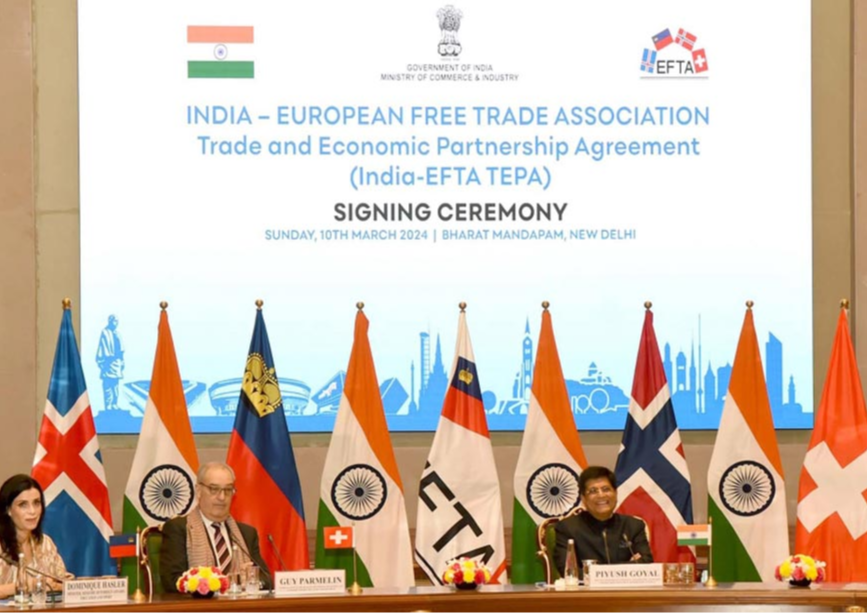-
CENTRES
Progammes & Centres
Location
Whether the new India-EFTA trade deal that has been touted as “modern, fair, and equitable” would be able to correct the prevalent trade imbalance remains to be seen

On 10 March, in a first, India signed a Free Trade Agreement (FTA) with a Western grouping of four developed nations. The European Free Trade Association (EFTA)—a key economic bloc in Europe—comprises the four non-EU countries of Switzerland, Norway, Iceland, and Liechtenstein. Despite a small population of 13 million, the bloc has a combined GDP of over US$1 trillion and is the world’s ninth-largest trader in goods and fifth-largest in services.
Following the European Union (EU), United States (US), United Kingdom (UK) and China, India is the grouping’s fifth largest trade partner, with two-way trade amounting to US$25 billion in 2023. In the same year, India’s exports to the bloc, consisting of iron and steel, chemicals, precious stones, machinery, yarns, pharmaceuticals, and sports goods, were valued at only US$2 billion. Simultaneously, India’s imports from the bloc were valued at around US$20 billion—the majority of which were gold imports from Switzerland, along with coal, silver, machinery equipment, engineering products, and medical devices. This reflects India’s huge trade deficit with the four countries.
India’s imports from the bloc were valued at around US$20 billion—the majority of which were gold imports from Switzerland, along with coal, silver, machinery equipment, engineering products, and medical devices.
The newly signed Trade and Economic Partnership Agreement (TEPA) is expected to enhance two-way market access, boost exports, reduce tariffs, promote investment, create opportunities for businesses, jobs, and resilient supply chains, and deepen overall economic integration and growth.
Negotiations for the deal commenced in 2008, paused in 2013, and culminated this month in 2024 after 21 rounds of talks. Commerce Minister Piyush Goyal touted the agreement as “modern, fair and equitable”—an important milestone in India’s relations with the bloc.
The TEPA has 14 chapters, which include trade in goods, services, rules of origin, intellectual property rights (IPRs), investment promotion, government procurement and technical barriers, amongst others. For the first time, India has allowed coverage of non-trade aspects in a trade agreement, including labour standards, social development, and environmental protection.
Under the deal, India has offered 82.7 percent of its tariff lines while EFTA countries have offered 92.2 percent. It is estimated that the deal would generate over a million jobs in India over 15 years and reduce unemployment, which is a key issue for the country. It will also facilitate the smoother movement of skilled Indian professionals into the bloc’s countries. This is likely to boost India’s service exports in the sectors of IT, finance, maritime, recreational, and professional services.
A unique component in the agreement is the chapter on investment, where the EFTA bloc has made a binding commitment to invest US$100 billion in India over 15 years. The investments, mostly from the private sector, will be aimed at manufacturing and industries such as chemicals, pharmaceuticals, machinery, food processing, infrastructure and transport. According to reports, India has already invited Swiss companies to invest in its railways. The bloc’s strengths in renewables, infrastructure, innovation and R&D complement India’s priorities. The deal will facilitate tech collaboration and provide India with access to world-class technologies.
The investments, mostly from the private sector, will be aimed at manufacturing and industries such as chemicals, pharmaceuticals, machinery, food processing, infrastructure and transport.
However, it will take at least a year (or longer) for the pact to be ratified and entered into force. In the case of Switzerland, a nationwide referendum may be held, similar to the one held on the Indonesia-EFTA FTA that was signed in 2018 but came into effect in 2021.
Recent years have seen India attempt to change its approach to trade and abandon its previous protectionism, which led to a last-minute exit from the Regional Comprehensive Economic Partnership (RCEP) agreement in 2019.
Geopolitical imperatives enmeshed with economics have served as key drives in this shift towards greater openness to trade deals. Both European nations and India are looking to diversify trade partners and reconfigure supply chains in favour of more ‘like-minded’ nations.
India is increasingly integrating itself into the global economy, as evident in the recent trade agreements signed with Australia and the United Arab Emirates (UAE). This momentum has been accompanied by wide-ranging internal reforms, improved ease of doing business, and ambitions to increase yearly exports to US$1 trillion by 2030. With Indian general elections around the corner, as Michael Kugelman from the Wilson Center asserts, trade deals are being showcased as “pro-people, pro-business, pro-growth, and pro-jobs”.
Despite the deal being touted as a win-win for all countries involved, for India, the benefits are limited in terms of trade in goods, given pre-existing low tariff rates in the EFTA bloc and most imports already receiving tariff-free treatment.
Out of EFTA’s US$11 billion investment from the last two decades in India, US$10 billion came from Switzerland. As the Global Tax Research Initiative (GTRI) reiterates, 91 percent of products will be traded between India and Switzerland, which is the bloc’s most important economic partner for India. For Indian consumers and importers, the reduction of tariffs would lower the prices of Swiss chocolates, biscuits, watches, wines, machinery equipment and medical devices. However, for India’s exports to Switzerland, already 98 percent of these (largely comprising industrial goods) have zero tariffs levied on them. Besides, since January 2024, Switzerland has imposed a policy to eliminate duties for industrial imports from all countries, which would negate the benefits to Indian exporters.
As the Global Tax Research Initiative (GTRI) reiterates, 91 percent of products will be traded between India and Switzerland, which is the bloc’s most important economic partner for India.
On the other hand, for the EFTA nations, the benefits are obvious—greater access to a vast market of 1.4 billion people and its rapidly rising middle class. The deal would see India partially eliminate customs duties on 95 percent of industrial goods from Switzerland, and increase imports of Swiss goods. According to Norway’s Industry Minister Jan Christian Vestre, the deal would levy almost zero import taxes on most Norwegian products, down from the current tax rate of 40 percent. Thus, the deal would more positively impact EFTA’s exports to India rather than Indian exports, given the reduction of Indian tariffs and enhanced market access. Despite this, gold imports from Switzerland, accounting for over 80 percent of India-EFTA trade, are excluded from tariff reductions.
Moreover, agricultural products remain outside the pact’s scope, besides the exclusion of several sensitive Indian products such as dairy, coal, and soya. Accounting for 41 percent of employment, the agriculture sector is the largest source of livelihood in India and its exports have rapidly increased since the Comprehensive Agriculture Export policy launched in 2018. With the World Trade Organisation’s inclusion of India in its top 10 list of agricultural exporters, India aims to further increase its agricultural exports to US$100 billion. Yet despite these ambitions, fear of European agricultural goods replacing Indian products has long rendered this sector the most contentious in trade negotiations. With ongoing protests in India and farmers being a key constituency, India continues to resist openness in this sector. In addition, compliance with European quality and safety standards is a challenge.
With ongoing protests in India and farmers being a key constituency, India continues to resist openness in this sector.
Even though the investment section of the deal is significant, the commitment by the EFTA countries excludes pension and sovereign wealth funds. Moreover, according to an assessment by the Business Standard, India’s nominal GDP needs to grow above 9 percent over the coming 15 years for the FDI to materialise.
India’s ties with European countries have strengthened in recent years, with cooperation spanning a wide range of areas. A deepening of economic engagement is a natural progression. Yet even though the investment portion is significant, whether the deal would garner substantial trade benefits for the Indian economy and correct the prevalent trade imbalance remains to be seen.
On a more symbolic level, India’s ability to finalise a trade deal with a developed bloc of European nations is promising, especially with India’s ongoing negotiations with the UK and EU. Yet it is unlikely for the EFTA deal to be a template for the much larger EU-India FTA, which is much more complex given the size and complexity of the markets involved.
The omission of agriculture, also a major bone of contention in the EU-India negotiations, from the EFTA deal means more is needed to get through this hurdle and sign on to more substantial deals. On a brighter note, India’s nod to include labour standards and other such provisions is significant given how important these issues are for the EU. Furthermore, the investment component may set a precedent for deals with other developed countries in return for market access to India.
For now, India can celebrate the EFTA deal, but an FTA with the EU is still where the real gold remains.
Shairee Malhotra is an Associate Fellow with the Observer Research Foundation.
The views expressed above belong to the author(s). ORF research and analyses now available on Telegram! Click here to access our curated content — blogs, longforms and interviews.

Shairee Malhotra is Associate Fellow, Europe with ORF’s Strategic Studies Programme. Her areas of work include Indian foreign policy with a focus on EU-India relations, ...
Read More +